Long exposure photography on your smartphone can transform ordinary landscapes into enchanting masterpieces. Modern phones boast advanced sensors and computational features that rival traditional cameras, allowing you to capture silky-smooth water, dramatic cloud streaks, and stunning night skies. With dedicated apps and manual controls, you'll have precise command over shutter speed, ISO, and focus. Pair these capabilities with proper stabilization techniques, and you'll achieve professional-quality results. The key is mastering your phone's settings, selecting the right scene, and applying creative post-processing. By honing these skills, you'll reveal a world of artistic possibilities in landscape photography right from your pocket.
Understanding Long Exposure Photography
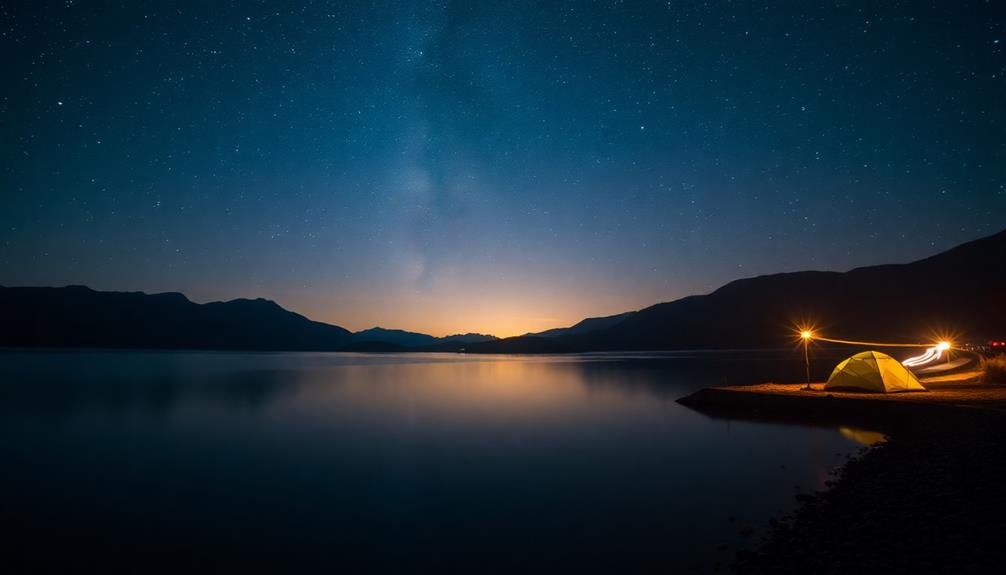
What exactly is long exposure photography? It's a technique where you keep your camera's shutter open for an extended period, typically several seconds or even minutes. This method allows more light to enter the camera, creating unique visual effects that can't be seen with the naked eye.
In landscape photography, long exposures are particularly effective. They can smooth out water surfaces, creating a dreamy, silky appearance in rivers, waterfalls, or oceans. Moving clouds become streaks across the sky, adding drama and dynamism to your images. Stationary objects remain sharp while anything in motion blurs, creating a contrast that draws the viewer's eye.
To achieve long exposures, you'll need to stabilize your phone using a tripod or a stable surface. Many modern smartphones have built-in long exposure modes, but you can also use third-party apps for more control.
You'll often need to use neutral density filters to reduce the amount of light entering the lens, especially during daytime shoots. By mastering long exposure techniques, you'll open up a new world of creative possibilities in your landscape photography.
Smartphone Camera Capabilities
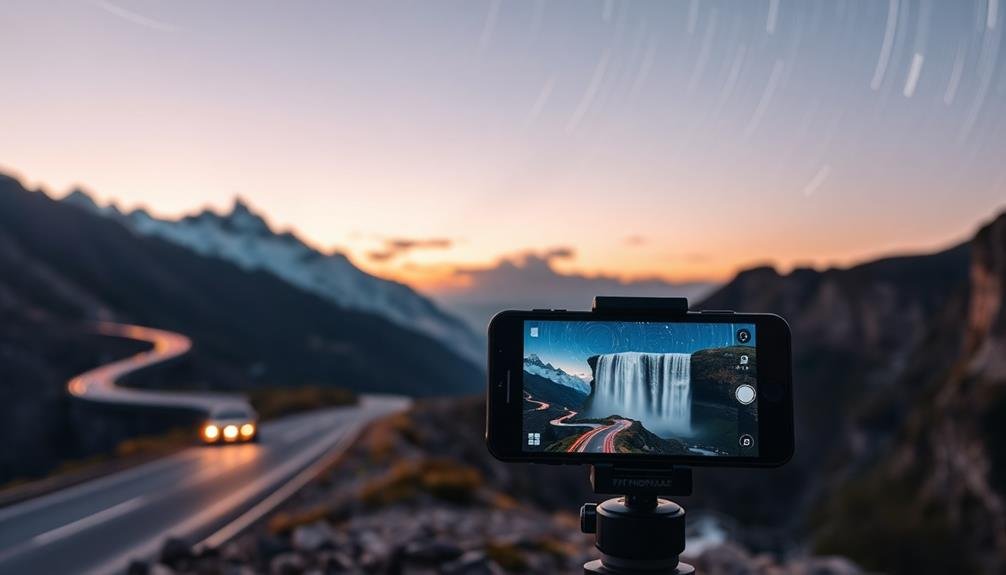
Your smartphone's advanced sensor technology allows for impressive low-light performance and high-resolution captures.
You'll find that modern computational photography features enhance long exposure shots, reducing noise and improving dynamic range.
These capabilities enable you to create stunning landscape images with your phone, rivaling those taken with traditional cameras.
Advanced Sensor Technology
Innovation in smartphone camera sensors has revolutionized mobile photography, enabling long exposure capabilities once reserved for high-end DSLRs.
Today's advanced sensors boast larger pixel sizes and improved light sensitivity, allowing you to capture more detail in low-light conditions. These sensors also feature higher resolutions, giving you the ability to crop images without significant loss in quality.
You'll find that modern smartphone cameras utilize backside-illuminated (BSI) sensors, which enhance light gathering by placing photodiodes closer to the surface. This design reduces noise and improves overall image quality, especially in challenging lighting situations.
Many high-end phones now incorporate stacked CMOS sensors, which separate the light-capturing layer from the processing circuitry, further boosting performance and reducing power consumption.
Another key advancement is the implementation of larger sensor sizes, such as 1/1.7" or even 1" formats in some models. These larger sensors capture more light, resulting in better dynamic range and improved low-light performance – essential factors for successful long exposure shots.
Combined with sophisticated image processing algorithms, these sensors enable you to create stunning landscape photographs that rival those taken with traditional cameras.
Computational Photography Features
Computational photography features in modern smartphones have transformed the way we capture long exposure landscapes. These advanced algorithms and software capabilities enable you to create stunning long exposure effects without the need for traditional camera equipment.
One key feature is exposure stacking, which allows you to take multiple shots and combine them into a single image. This technique helps reduce noise and increase dynamic range, resulting in cleaner, more detailed long exposures.
Another powerful tool is AI-powered scene recognition, which automatically adjusts settings for ideal landscape shots. Your phone's built-in HDR (High Dynamic Range) mode is particularly useful for long exposures, as it can balance bright skies with darker foregrounds.
Many smartphones now offer dedicated long exposure modes, making it easy to capture silky-smooth waterfalls or light trails. Motion blur reduction algorithms help compensate for hand shake during longer exposures, allowing you to shoot without a tripod in some situations.
Additionally, advanced noise reduction techniques help maintain image quality even in low-light conditions, which is essential for many landscape scenarios.
Essential Long Exposure Apps
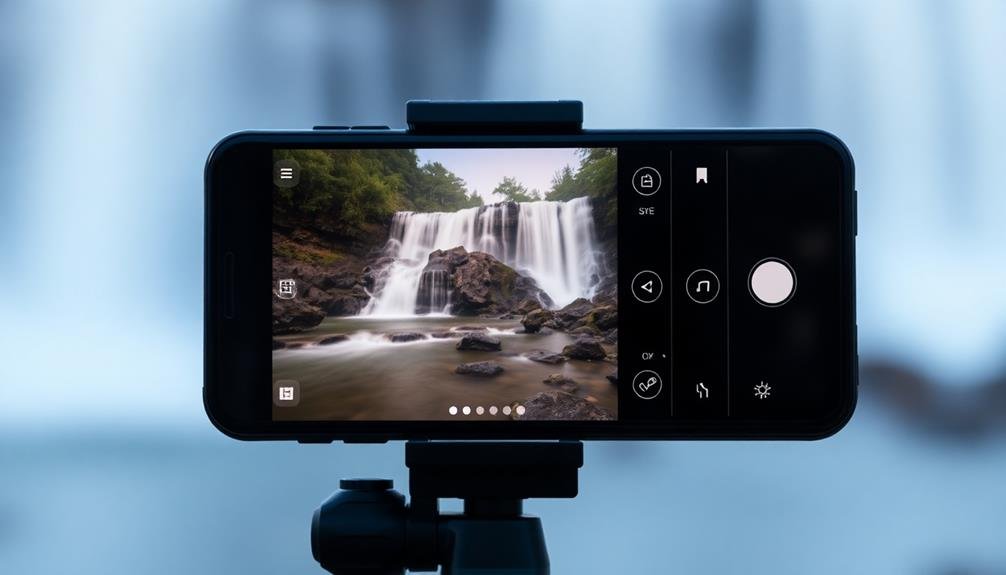
To capture stunning long exposures on your smartphone, you'll need to equip yourself with the right apps.
Start by exploring top-rated exposure control apps that offer manual settings, allowing you to adjust shutter speed, ISO, and focus.
Don't forget to reflect on post-processing tools, which can enhance your long exposure shots and help you achieve the desired landscape effects.
Top-Rated Exposure Control Apps
While mastering long exposure photography on your phone requires skill, having the right apps can greatly enhance your capabilities. Here are some top-rated exposure control apps that'll help you capture stunning landscape shots:
| App Name | Key Features | Platform |
|---|---|---|
| Slow Shutter Cam | Manual exposure control, light trail mode | iOS |
| Camera FV-5 | DSLR-like manual controls, exposure bracketing | Android |
| ProCam X | RAW capture, exposure compensation | iOS, Android |
These apps offer advanced features that'll give you greater control over your long exposure shots. Slow Shutter Cam excels at creating light trails and motion blur effects, while Camera FV-5 provides a user-friendly interface with professional-grade controls. ProCam X stands out for its ability to capture RAW images, allowing for more flexibility in post-processing.
When choosing an app, consider your specific needs and your phone's capabilities. Some apps may offer features that your device's hardware can't fully utilize. Remember, the best app for you is one that you're comfortable using and that helps you achieve your desired results consistently. Don't be afraid to experiment with different apps to find the perfect fit for your photography style.
Manual Settings for Smartphones
Mastering manual settings on your smartphone is the next step in elevating your long exposure photography. Most modern smartphones offer manual controls that rival those of DSLR cameras.
To achieve stunning long exposures, you'll need to adjust three key settings: ISO, shutter speed, and focus.
Start by setting your ISO to the lowest possible value, typically 50 or 100. This reduces noise and allows for longer exposures. Next, experiment with shutter speeds ranging from 1/2 second to 30 seconds, depending on your subject and available light. For moving water or clouds, try 2-10 seconds. Longer exposures work well for star trails or light painting.
Use manual focus to guarantee your subject remains sharp. Many phones offer focus peaking, which highlights in-focus areas. Don't forget to stabilize your phone using a tripod or sturdy surface.
Some phones also allow you to adjust white balance and exposure compensation. Fine-tune these settings to capture the mood you're after. With practice, you'll learn to balance these elements to create enthralling long exposure landscapes right from your smartphone.
Post-Processing Tools Recommended
Post-processing powerhouses can transform your smartphone long exposures from good to breathtaking. With the right apps, you'll enhance colors, adjust exposure, and fine-tune details to create stunning landscape images.
For iOS users, Snapseed and Lightroom Mobile offer powerful editing tools. Android photographers can rely on VSCO and Pixlr. These apps provide essential features like selective adjustments, noise reduction, and advanced sharpening.
Here's a quick comparison of top post-processing apps for long exposure landscapes:
| App Name | Platform | Key Features |
|---|---|---|
| Snapseed | iOS/Android | Selective editing, Curves, HDR |
| Lightroom Mobile | iOS/Android | RAW support, Presets, Cloud sync |
| VSCO | iOS/Android | Film-like filters, Advanced tools |
| Pixlr | iOS/Android | AI-powered effects, Layer editing |
| TouchRetouch | iOS/Android | Object removal, Line removal |
When editing your long exposures, focus on enhancing the smooth water or cloud movements. Use gradient filters to balance exposure between sky and foreground. Don't shy away from experimenting with different looks, but remember to maintain a natural appearance. With practice, you'll develop a signature style that makes your phone long exposures truly shine in landscapes.
Selecting the Perfect Landscape Scene
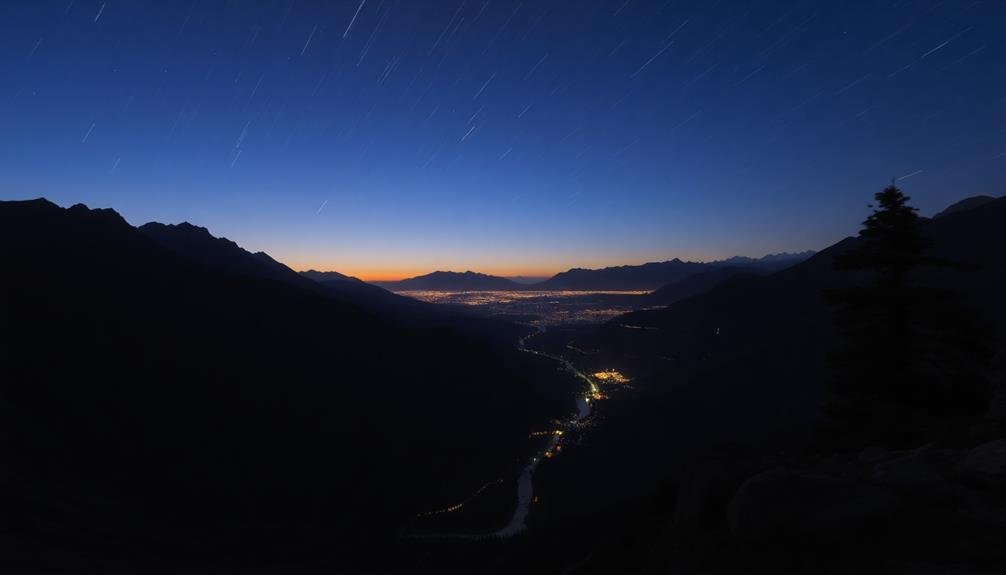
Choosing the right landscape scene is vital for successful phone long exposures. You'll want to look for elements that create visual interest when blurred or smoothed over time. Water features like rivers, waterfalls, or seascapes are excellent choices, as they'll transform into silky streams or misty expanses. Clouds can also add drama, especially if they're moving quickly across the sky.
Consider the overall composition of your scene. Look for strong foreground elements that'll remain sharp, contrasting with the blurred motion. Rocky shorelines, sturdy trees, or architectural features can anchor your image. Pay attention to the direction of movement in your scene. Horizontal motion, like waves or passing clouds, can create a sense of calm, while vertical movement, such as waterfalls, adds dynamism.
Timing is critical. Shoot during the golden or blue hour for soft, warm light that complements long exposures. Be mindful of potential distractions that might detract from your main subject.
Mastering Smartphone Stabilization Techniques
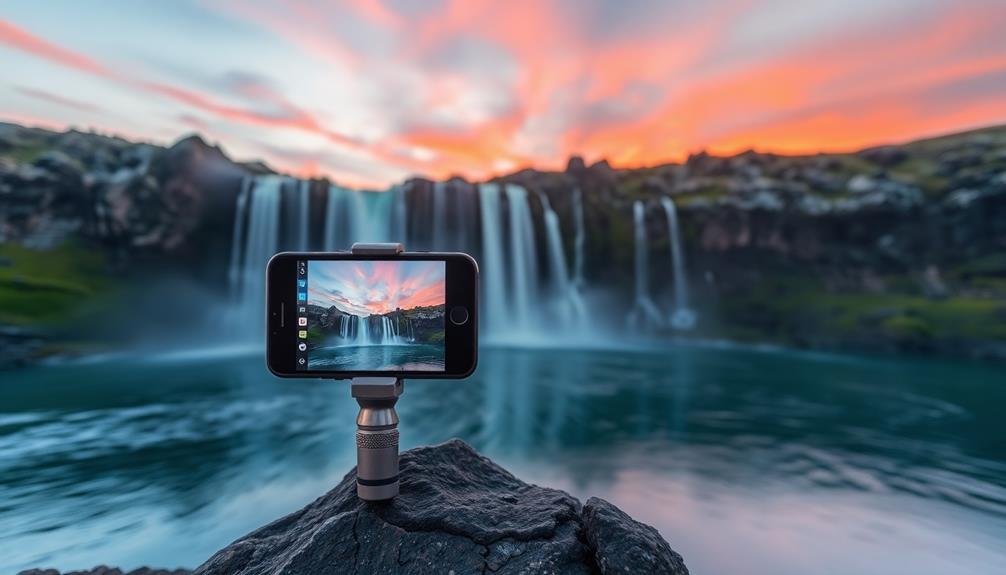
Achieving sharp long exposures with your smartphone requires mastering stabilization techniques.
You'll find that tripods are essential for steady shots, but handheld methods can also produce impressive results when used correctly.
For even more stability, explore app-assisted tools that enhance your phone's built-in image stabilization capabilities.
Tripods for Steady Shots
When it comes to capturing stunning long exposure landscapes with your smartphone, a steady shot is essential. While stabilization techniques are helpful, nothing beats a reliable tripod for achieving razor-sharp images. You'll want to invest in a lightweight, portable tripod that's compatible with your phone.
Look for tripods with adjustable legs and a ball head for versatile positioning. Some models come with smartphone adapters, but you can also purchase these separately. Ascertain the adapter securely holds your device and allows easy access to controls.
For added stability, consider a tripod with a center column hook where you can hang your bag for extra weight. Don't forget about mini tripods or flexible options like Gorillapods for unique angles and tight spaces.
When setting up your tripod, extend the thickest legs first for maximum stability. Use the bubble level to ascertain your horizon is straight. If shooting in windy conditions, keep the tripod low to the ground and use your body as a windbreak.
Handheld Stabilization Methods
While tripods offer unparalleled stability, you won't always have one on hand. That's when handheld stabilization methods become essential for achieving sharp long exposures. Start by adopting a stable stance: feet shoulder-width apart, elbows tucked in, and the phone held close to your body. Breathe steadily and gently press the shutter button to minimize camera shake.
Utilize your surroundings for added support. Lean against a tree, wall, or rock to reduce body movement. If possible, rest your elbows on a flat surface like a fence or ledge. Some photographers even carry a small beanbag to create a makeshift support for their phone.
Many smartphones now offer built-in stabilization features. Enable optical image stabilization (OIS) or electronic image stabilization (EIS) in your camera settings. Some apps provide additional stabilization options, such as delayed shutter release or voice-activated shooting.
Consider using the volume buttons or headphones as a remote shutter release to avoid touching the screen. Finally, take multiple shots in burst mode to increase your chances of capturing a sharp image.
With practice, you'll master these techniques and capture stunning handheld long exposures.
App-Assisted Steadiness Tools
Smartphone photographers now have a powerful arsenal of app-assisted steadiness tools at their fingertips. These apps leverage your phone's built-in gyroscope and accelerometer to enhance stability during long exposures.
You'll find options like Slow Shutter Cam, ProCam, and NightCap Camera, which offer advanced stabilization features. When using these apps, you'll typically see a real-time stabilization indicator on your screen. This guide helps you maintain a steady hand by showing how much movement is occurring.
Some apps even allow you to set a movement threshold, only capturing the image when your phone is sufficiently still. Another useful feature is automatic image stacking. This technique takes multiple shots and combines them to reduce noise and increase sharpness.
You'll also find apps that offer post-capture stabilization, aligning and blending multiple frames to create a crisp final image. Don't overlook the power of remote shutter release features. Many apps allow you to trigger the shutter using voice commands or your smartwatch, eliminating the need to touch your phone and potentially introduce shake.
Adjusting Exposure Settings on Phones
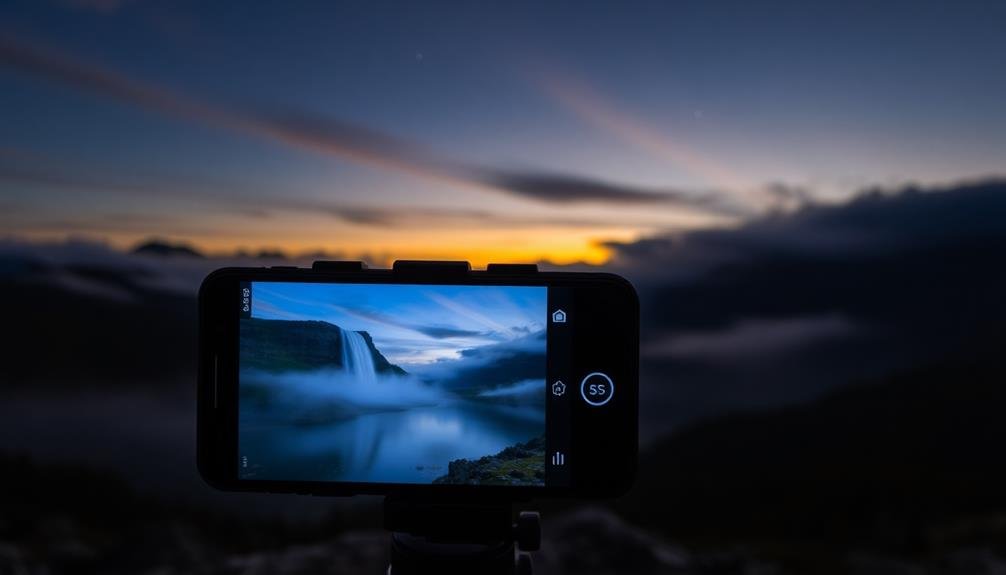
Modern phones pack powerful cameras with manual controls, giving you unprecedented control over exposure settings. You'll find options to adjust ISO, shutter speed, and aperture, allowing you to craft the perfect long exposure shot.
Start by switching to your phone's "Pro" or manual mode, usually found in the camera app's settings.
To capture stunning long exposures in landscapes:
- Lower your ISO: Set it between 50-200 to reduce noise and improve image quality.
- Slow down the shutter speed: Try 1/4 second for flowing water, or several seconds for star trails.
- Adjust aperture: Use f/8 to f/11 for sharper landscapes with greater depth of field.
- Enable long exposure noise reduction: This helps minimize graininess in your final image.
Remember to experiment with different combinations of these settings to achieve your desired effect.
As you adjust one parameter, you'll need to compensate with others to maintain proper exposure. For instance, if you slow down the shutter speed, you may need to decrease ISO or close the aperture to avoid overexposure.
With practice, you'll master these controls and create enchanting long exposure landscapes using just your phone.
Capturing Water and Cloud Movement
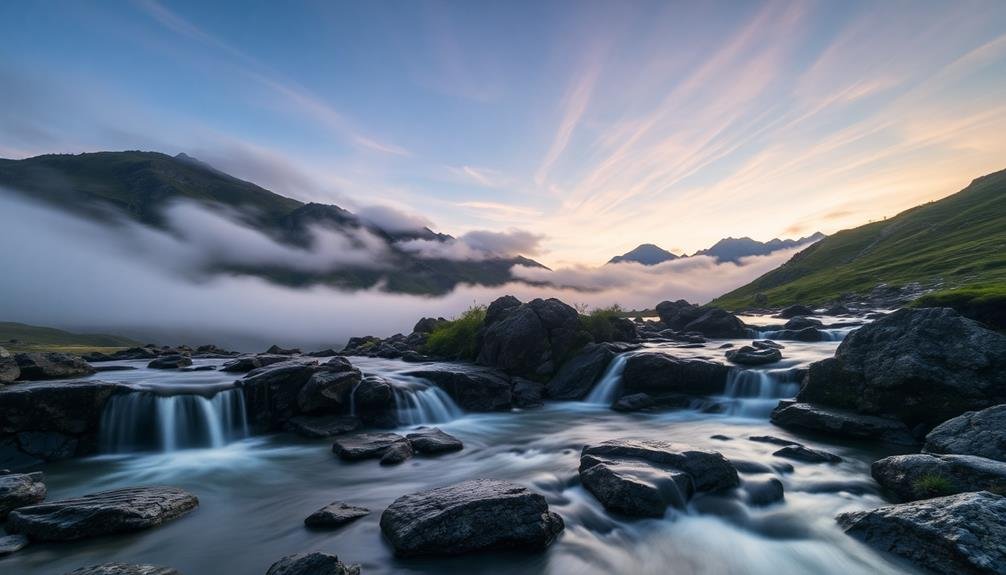
Harnessing the power of long exposure photography, you can transform ordinary landscapes into mesmerizing scenes of fluid motion. When capturing water and cloud movement, you'll create ethereal effects that add dynamism to your images. Focus on flowing rivers, cascading waterfalls, or crashing waves to produce silky-smooth water textures. For clouds, aim to capture their gradual movement across the sky, resulting in dramatic streaks or a dreamy, cotton-like appearance.
To achieve these effects, you'll need to experiment with different shutter speeds. Here's a guide to help you get started:
| Subject | Shutter Speed | Effect | Best Time | Tips |
|---|---|---|---|---|
| Waterfalls | 1-4 seconds | Silky water | Overcast day | Use a neutral density filter |
| Ocean waves | 1/2-2 seconds | Misty surf | Golden hour | Secure your phone on a tripod |
| Rivers | 1-30 seconds | Smooth, glassy surface | Early morning | Experiment with compositions |
| Fast clouds | 30-60 seconds | Streaking effect | Windy day | Use manual focus |
| Slow clouds | 2-4 minutes | Soft, cotton-like texture | Calm day | Enable long exposure mode |
Remember to adjust your settings based on lighting conditions and the desired effect you're aiming for in your landscape shots.
Night Sky Photography With Smartphones
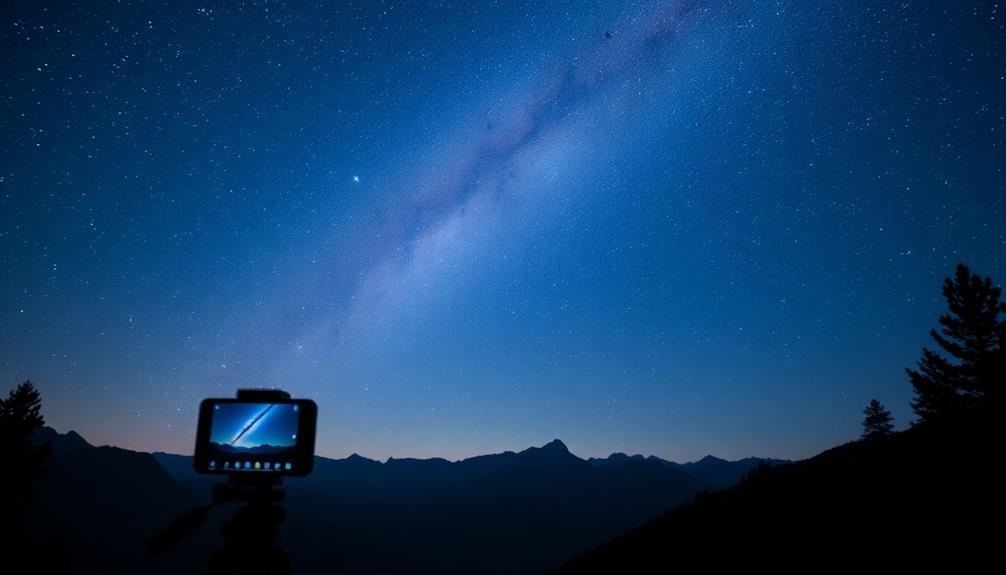
Stargazers and night photography enthusiasts can now capture stunning celestial scenes using their smartphones. Modern phone cameras, equipped with advanced sensors and computational photography, have made night sky photography more accessible than ever.
You'll need to use your phone's manual or pro mode to control settings like ISO, shutter speed, and focus. Opt for a longer exposure time, typically between 15 to 30 seconds, to gather enough light from the stars. A sturdy tripod is essential to keep your phone steady during these extended exposures.
To enhance your night sky photos, consider these tips:
- Find a dark location away from light pollution
- Use a wide-angle lens attachment for a broader field of view
- Focus manually on a bright star or distant light source
- Experiment with stacking multiple exposures for reduced noise
Don't forget to enable your phone's night mode or astrophotography mode if available. These features use AI and image processing to bring out details in the night sky.
With practice and patience, you'll be amazed at the celestial wonders you can capture using just your smartphone.
Post-Processing Long Exposure Phone Images

Once you've captured your long exposure images, post-processing can elevate them from good to great. Start by adjusting the exposure and contrast to bring out the details in both highlights and shadows. Don't be afraid to push the limits, as long exposures often benefit from a slightly dramatic look.
Focus on enhancing the motion blur that's unique to long exposures. Increase clarity and texture in static elements while smoothing out areas of movement, like water or clouds. This contrast will emphasize the dreamy effect of your long exposure.
Color grading is essential. Experiment with white balance to set the mood, and use selective color adjustments to make specific elements pop. For night shots, reduce noise carefully to preserve details.
Crop your image thoughtfully to improve composition if needed. Consider using gradient filters to balance exposure across the frame, especially for landscape shots with bright skies.
Creative Effects in Phone Landscapes
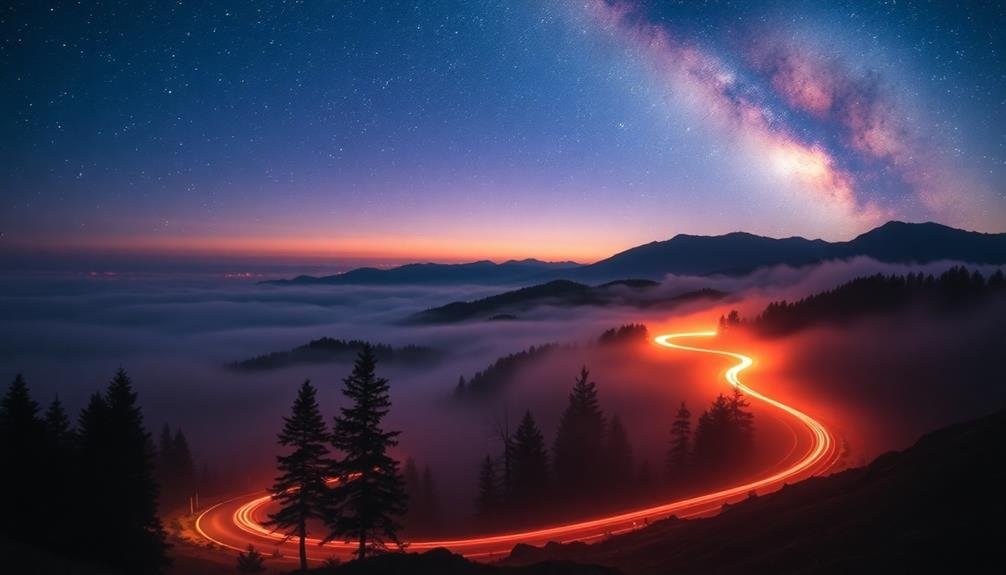
While long exposures offer a unique perspective on landscapes, you can take your phone photography even further with creative effects. By combining long exposure techniques with other creative approaches, you'll capture truly unique and enchanting images that stand out from the crowd.
One popular technique is light painting, where you use artificial light sources to "paint" elements into your long exposure landscape. This can create stunning results, especially in low-light conditions.
Another creative effect is zooming during exposure, which produces a dynamic, radial blur effect that draws the viewer's eye to the center of the image.
Here are four more creative effects to try in your phone landscapes:
- Multiple exposures: Blend several images for a surreal, dreamlike quality
- Intentional camera movement: Create abstract patterns by moving your phone during exposure
- Reflections: Use water surfaces to create symmetrical compositions
- Silhouettes: Expose for the sky to create dramatic, high-contrast images
Experimenting with these techniques will help you develop your unique style and push the boundaries of phone landscape photography.
Don't be afraid to combine multiple effects for even more striking results.
Overcoming Smartphone Camera Limitations
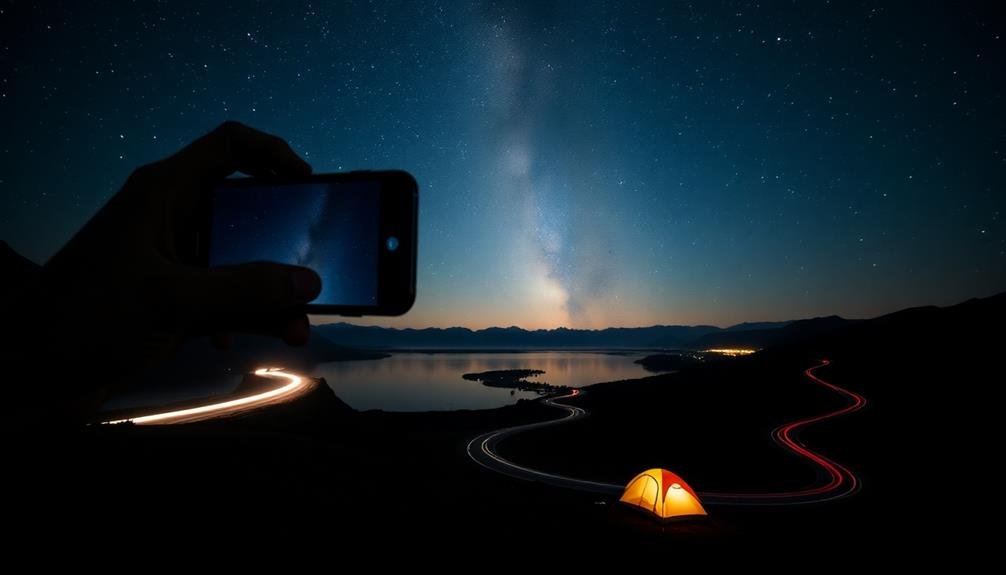
Despite their impressive capabilities, smartphone cameras still have limitations when it comes to long exposure photography. You'll need to overcome these challenges to capture stunning landscape images.
First, tackle the issue of camera shake by using a tripod or stabilizing your phone against a solid surface. This guarantees sharp, blur-free images during longer exposures.
To compensate for the smaller sensor size, increase your ISO slightly, but be cautious of introducing noise. Use manual mode or a dedicated long exposure app to gain more control over shutter speed and exposure settings. These tools allow you to capture exposures lasting several seconds or even minutes.
Overcome the lack of built-in neutral density filters by purchasing clip-on or magnetic ND filters designed for smartphones. These accessories help you achieve longer exposures in bright conditions without overexposing your image.
To combat limited dynamic range, try bracketing your exposures and blending them in post-processing. This technique helps you capture details in both highlights and shadows.
Frequently Asked Questions
How Does Temperature Affect Long Exposure Photography on Smartphones?
Temperature can greatly impact your long exposure shots on smartphones. In colder conditions, you'll see less noise and better battery life. However, extreme heat can cause overheating, leading to app crashes and potential damage to your phone's camera sensor.
Can Smartphone Long Exposures Capture Star Trails Effectively?
You can capture star trails with smartphone long exposures, but results may be limited. You'll need a stable tripod, a dark sky, and manual camera settings. Try stacking multiple exposures for better results.
What Are the Best Waterproof Cases for Underwater Long Exposure Photography?
You'll want to contemplate popular waterproof cases like AxisGo, ProShot, and Outex for underwater long exposure photography. They're designed to protect your phone while allowing full access to controls. Don't forget to look for depth ratings and lens compatibility.
How Do Different Smartphone Brands Compare for Long Exposure Capabilities?
You'll find iPhones and high-end Android phones like Samsung and Google Pixel offer excellent long exposure capabilities. They've got advanced night modes, manual controls, and dedicated apps. However, specific features and performance can vary between models and generations.
Are There Any Health Risks Associated With Extended Nighttime Smartphone Photography Sessions?
You're right to be concerned. Extended nighttime smartphone photography can strain your eyes and disrupt sleep patterns. It's also important to be aware of your surroundings for safety. Take breaks and limit your exposure when possible.
In Summary
You've now got the tools to create stunning long exposure landscapes with your smartphone. By understanding your device's capabilities, using the right apps, and mastering stabilization techniques, you'll capture breathtaking scenes day and night. Don't forget to experiment with creative effects and post-processing to elevate your images. With practice, you'll overcome your phone's limitations and produce professional-quality long exposures that rival those from traditional cameras. So get out there and start shooting!

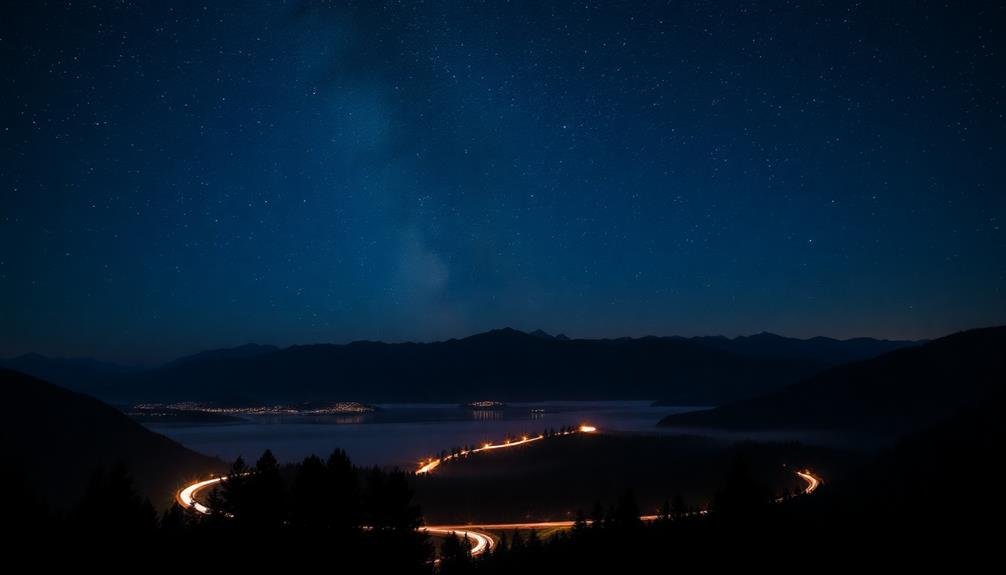



Leave a Reply